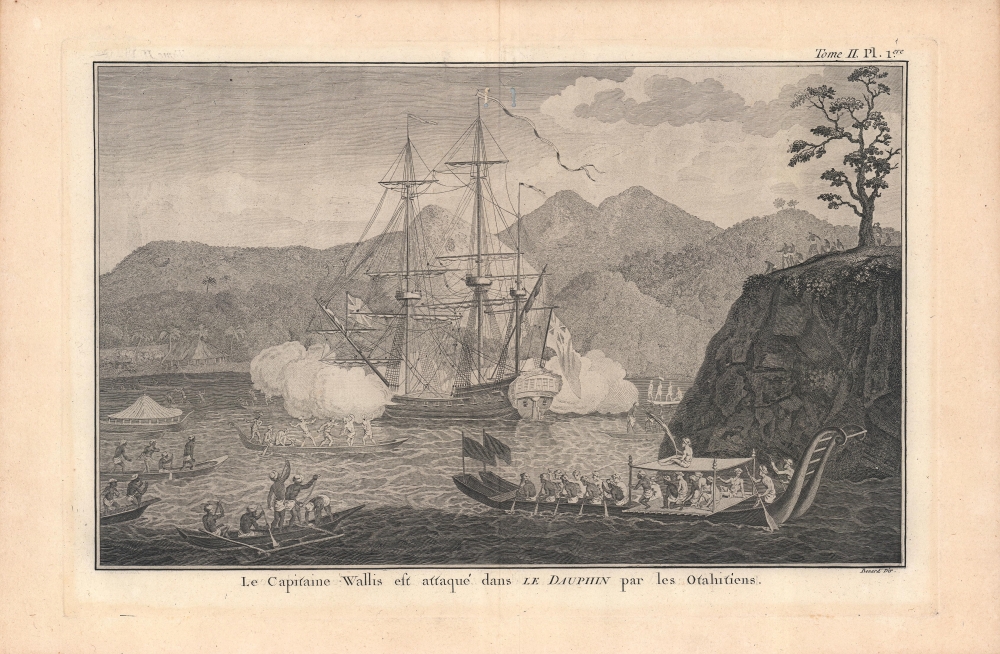This item has been sold, but you can get on the Waitlist to be notified if another example becomes available, or purchase a digital scan.
1774 Hawkesworth / Benard View of the HMS Dolphin in Tahiti
WallisTahiti-hawkesworth-1774
Title
1774 (undated) 8.5 x 13 in (21.59 x 33.02 cm)
Description
A Closer Look
This view depicts the HMS Dolphin in Matavai Bay, Tahiti, which the ship reached in late June 1767. Initially, Wallis and his crew hoped Tahiti (which they renamed 'King George III Island') was the long-sought Southern Continent. After anchoring, Wallis retired to his cabin, suffering from illness like much of his crew. After the British attempted to force the Tahitians to trade with them, the Tahitians rode out on canoes to attack the Dolphin with stones. The British responded with canon fire and the fracas ended with the Tahitians agreeing to trade. Staying for roughly a month, the British developed good relations with the Tahitians, especially Queen Purea (Oborea).Wallis' Pacific Voyage
Less well-known than some of his contemporaries, Captain Samuel Wallis (1728 - 1795) was nonetheless an important figure in late 18th century European exploration of the Pacific. Between 1766 and 1768, as commander of the HMS Dolphin, Wallis undertook a voyage of circumnavigation in accordance with Philip Carteret on the HMS Swallow (the Dolphin had already circumnavigated the world once under the command of John Byron). Wallis and Carteret were separated during a storm in the Straits of Magellan, but both continued with and completed their voyages, making important discoveries of islands in the South and Southwestern Pacific, which were deeply influential on later voyages, especially the first voyage of James Cook. However, neither Carteret or Wallis discovered the southern continent, and disease decimated the crews of both ships.Publication History and Census
This view was engraved by Robert Benard as Plate 1 in Volume II of Relation des voyages entrepris par ordre de Sa Majesté Britannique, actuellement regnante, pour faire des découvertes dans l'hémisphère méridional, a 1774 French translation of the book An Account of the Voyages… published the previous year by John Hawkesworth. The view is only independently cataloged in the holdings of the National Library of Australia. Hawkesworth's entire text is more widely distributed in institutional holdings, though somewhat less so in the French translation.CartographerS
John Hawkesworth (c. 1715 - November 16, 1773) was an English born writer and editor born London. Hawkesworth, who is said to have been self educated, succeeded Samuel Johnson as the parliamentary debate compiler for "Gentleman's Magazine". He was a deeply religious and moral map who brilliant defense of morality earned him an LL. D degree from the Archbishop of Canterbury. Hawkesworth went on to publish a series of scholarly books and essays including a 12 volume edition of Jonathan Swift's work. In 1772 Hawkesworth was commissioned by the Admiralty to compile and edit James Cook's journals. The resultant work An Account of the Voyages undertaken ... for making discoveries in the Southern Hemisphere was one of the first ethnographic account of the South Seas and was widely published in England and abroad. Though highly influential, Hawkesworth's work received heavy criticism from scholars who claim that he liberally altered much of the text in the name of morality. More by this mapmaker...
Robert Bénard (1734 - c. 1785) was a French engraver. Born in Paris, Bénard is best known for supplying a significant number of plates (at least 1,800) for the Encyclopédie published by Diderot and Alembert. He also is remembered for his work with the Académie des Sciences, most notably the Descriptions des Arts et Métiers Learn More...

